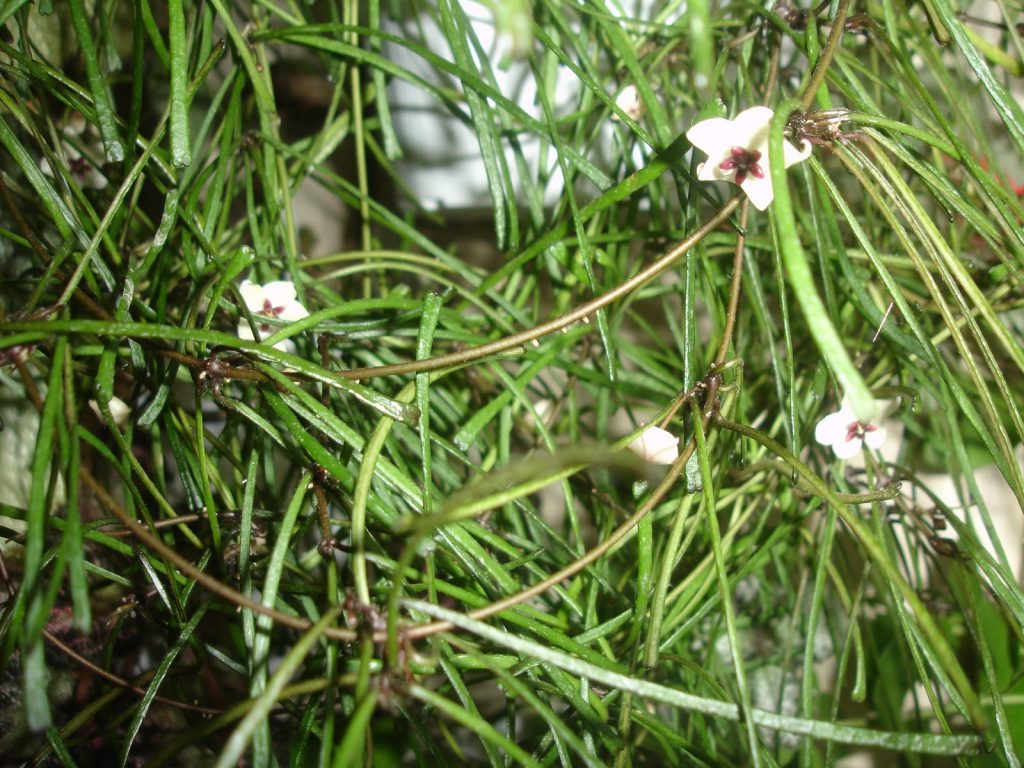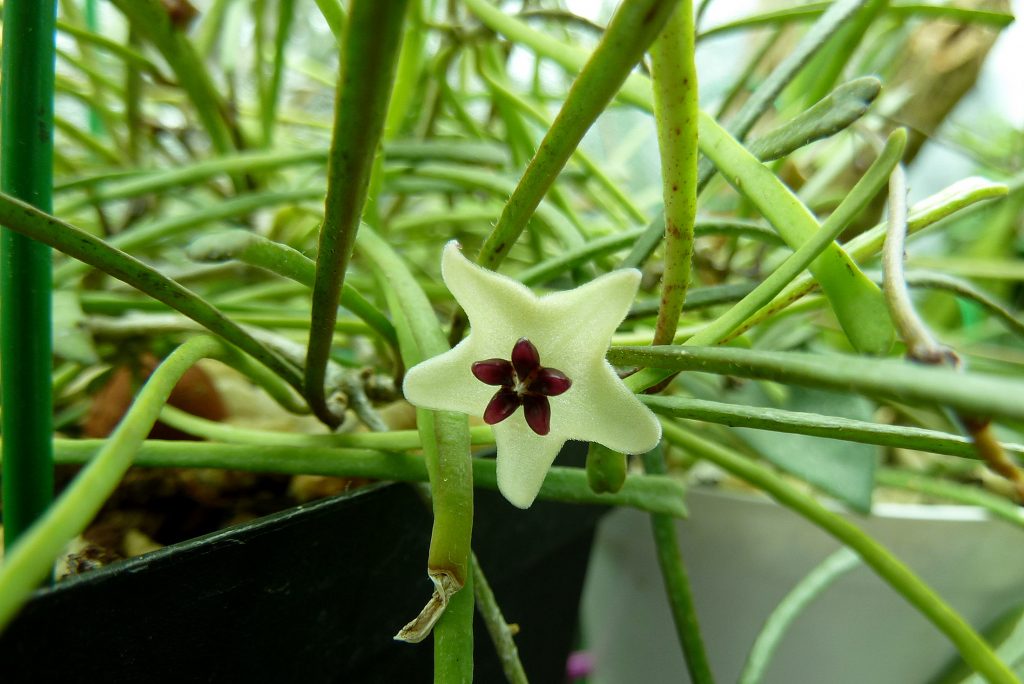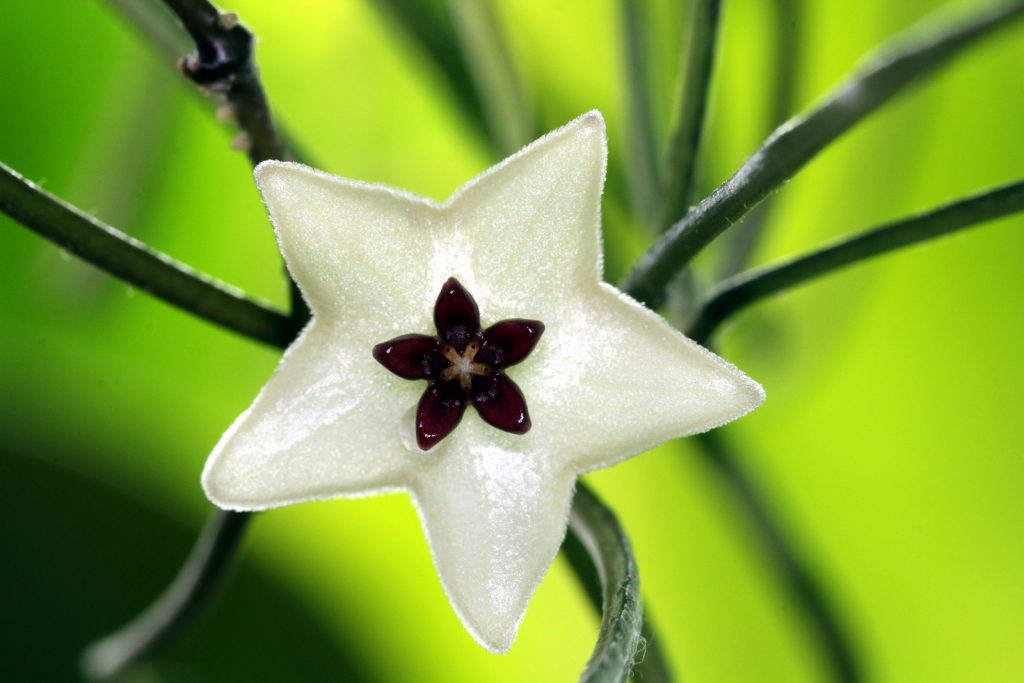Hoya Retusa - features of growing this fragile plant
Exotic hoya Retuza, originally from Indonesia, Australia and India, is one of the brightest and rarest representatives of the Lastovnevye family. The flower is not picky about the content, so every florist, even a beginner, can grow it. Consider the features of the variety, the rules of care and methods of reproduction.

Hoya retuza description
Characteristic
The botanical name is hoya retusa, also called Hoya Squeezed. This variety is ampelous, characterized by accelerated growth - per year the growth is from 5 to 50 cm.
The plant is perennial, evergreen, with very thin (like straws) climbing stems 2.5-3 m long. Leaves are emerald, fleshy, with a glossy surface, oval in shape.
Inflorescences are spherical, formed on arrows 2.5-6 cm in size. The flowers are small, with a circumference of 1.5 cm, of various colors - white, pale pink, burgundy, orange or yellow. Collected in 15-20 pcs. in tight umbrellas.
During the flowering period, the hoya thins out a pleasant fragrant aroma, the intensity of which increases towards evening.
Blooms throughout the summer. If the hoye is given proper care, repeated flowering can be achieved.
Purchase and adaptation
You can purchase an exotic flower seedling in a specialized store. When choosing, carefully inspect the crown - there should be no signs of diseases, parasites and mechanical injuries.
Leaves and shoots are juicy, fresh, rich in tone. The substrate is slightly damp, there is no mold or acidification on its surface.
After purchase, the hoya is quarantined for 20 days. During this time, you can determine its condition - if you find signs of diseases or pests, it is necessary to carry out treatment with pesticides. A week after treatment, they are transferred to a common room with other home vegetation.
Landing rules
Successful cultivation depends on the correct substrate and flower habitat.
A well-drained soil with a neutral or slightly acidic acidity reaction is suitable. You can prepare it yourself by mixing leaf and turf soil in equal parts.
To increase the loose structure, add a little coarse sand, perlite or vermiculite. As an additional food, a handful of crushed charcoal is mixed in. Then the mixture is calcined in an oven at a temperature of 100 ° C for half an hour or spilled with boiling water.
Many growers use ready-made land for growing decorative flowering plants.
Prefers to grow in a sunny location, but protected from direct rays. Therefore, a flowerpot with a flower is placed on the south or southwest window. At lunchtime, create partial shade.
The necessary conditions
There are several conditions that Retuse must provide when growing at home.

Hoya retuza
Temperature:
- The optimal regime in the warm season (from the beginning of spring to the end of summer) is 18-22 ° С.
- In autumn and winter, they are kept at a temperature of 10-12 ° C.
A decrease in indicators during the dormant period is not a prerequisite, but it contributes to high-quality and long-lasting flowering.
Hoya responds positively to frequent irrigation of the crown with warm water. During the period of active growth and development, they are sprayed every third day, in the cold season - once every two weeks to wash off the dust and prevent the appearance of a spider mite.
This is a culture of continuous light - it requires at least 12 hours a day.
In the warm season, this condition is provided by the sun's rays. Therefore, the flower is placed on the balcony, loggia, terrace, where there is protection from precipitation, wind and sun. In winter, illuminate with a fluorescent lamp.
Care rules
It is not difficult to take care of Hoya Retuza, the main thing is to carry out all activities on time and in accordance with the required standards.

Hoya retuza care
Watering
It prefers abundant moisture, but between waterings the soil should dry out to a depth of 3-4 cm. The flower tolerates short-term drought well, but does not tolerate waterlogging - the roots quickly rot.
Use settled, warm water (40 ° C). In spring and summer they are moistened once every 5-7 days, in winter - once every 3 weeks. If the plant is in a cool room, then in the cold season it is watered once a month.
Top dressing
The main care for a flower at home includes regular fertilization.
Nutrient solutions are applied only after watering - moisture helps to quickly assimilate nutrients. Gardeners use store-bought mineral formulations with a high potassium content.
They are fed during the entire growing season and flowering - once every two weeks.
Pruning
After the end of flowering, too-elongated lashes are pruned, as well as twigs growing in the wrong direction. Additionally, a sanitary haircut is required - all sick, yellowed and shrunken stems, leaves are cut out.
In young specimens, the apical leaves are pinched to stimulate the development of lateral processes.
The flower arrows, along with the inflorescences, after the hoya has faded, should not be touched, next year new buds will appear on them.
In adult plants, the stems reach large sizes, so they need to be supported by installing a trellis or wooden pegs.
Transfer
The technique for this procedure is simple:
- the flower is watered, taken out of the pot;
- together with an earthen lump, they are transferred into a flowerpot 2-3 cm larger in the diameter of the previous one;
- add fertile soil to the top, crush around the stems, moisten.
A purchased plant is transplanted after quarantine, young specimens - after a year, adults - every 4 years.
Also flowers with decayed roots need to be transplanted. They are removed from the container, washed off the remnants of the soil, cut out the rot, dipped for 2 hours in a fungicide solution. Dried, planted in a new pot with sterile soil.
Reproduction methods
This flower can be propagated in several ways, the cultivation technique is different for each.

Hoya retuza home care
Stem layering
Choose a flexible and strong shoot, make a 1 cm long incision on it. Wrap this place with moistened moss, then with a film. After a couple of weeks, the roots should break through the moss. Then the winding is removed, the stem is cut off from the mother plant, planted in a mixture of sod and leafy soil (1: 1). Water abundantly, put in a warm place with diffused daylight.
Cuttings
In spring, during sanitary pruning, several shoots 15-20 cm long are cut from the top of the stems. Each branch should have 2-3 leaves and the same number of buds. The foliage is cut off from below, dipped in Epin's solution for a couple of hours in order to stimulate the rapid growth of roots.
The workpieces are planted in a mixture of peat and sand to a depth of 3-4 cm. Watered, covered with a transparent film, placed on a windowsill with good lighting. Every day, the seedlings are ventilated, moistened as the substrate dries.
As soon as new leaves appear on them, the film is removed, they continue to look after for another month so that they are well overgrown with roots, then they are seated in separate pots.
Sheet
Several adult leaves with axillary buds are required. They are cut off from the stems, dipped in Kornevin's solution. They are planted in seedling boxes filled with a moist peat-sand mixture. Sprinkle with warm water, cover with transparent glass. Every day, planting is aired, moistened as the substrate dries. It can take 2 to 3 weeks for rooting.

Hoya retuza photo
As soon as the leaves begin to grow, the shelter is removed, and they continue to look after the seedlings. They are planted after the appearance of the stems - after 1.5-2 years.
Diseases and pests
Hoya Retusa has good resistance to infections and parasites. Infection is possible only if the conditions of detention and care rules are violated.
| Diseases and pests | Diagnostics | Treatment methods | Prophylaxis |
| Scale insect, aphid, mealybug, spider mite | When they appear, the leaves, young processes and buds begin to turn yellow, become covered with black spots, curl and dry out. These insects feed on the juice of all organs of the hoya. | First, diseased areas are cut out, then the crown and soil are treated with insecticides - Aktellik, Fitoverm, Karbofos, Decis or Aktara | Maintain the humidity and temperature in the room at the desired level, buy healthy plants, keep in quarantine, use sterile soil for planting, transplanting |
| Root rot | Due to excessive watering, the root system begins to rot, later the fungal infection spreads to the stems - they darken, become soft and slippery | The flower is taken out of the flowerpot, the soil is washed off, if the roots are completely rotted, they are disposed of. Several cuttings are taken for further cultivation of the variety. In case of partial defeat, all rot is cut out, the roots are dipped in a fungicide solution for 2 hours, dried, and the places of the cuts are sprinkled with charcoal. Are planted in sterile soil and a new pot | Avoid overflow, water the flowers with warm water (40 ° C) |

